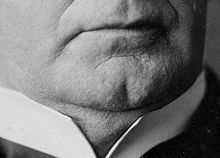Chin
![]()
The title of this article is ambiguous. For other meanings, see Chin (disambiguation).
The chin (lat. mentum) is the lower front of the face in the region of the lower jaw, which is supported by the protuberantia mentalis and the lateral cusps (tubercula mentalia) of the lower jaw on both sides. Above these lie the chin muscle (Musculus mentalis), to the side of it the pull-down muscle of the lower lip (Musculus depressor labii inferioris), and above it the lower portion of the mouth sphincter (Musculus orbicularis oris). These muscles belong to the mimic musculature and are innervated by the facial nerve. Sensory innervation is provided by the mental nerve, a branch of the inferior alveolar nerve. Blood supply is provided by the ramus mentalis of the inferior alveolar artery and vein. Below the chin, between the anterior bellies of the Mm. digastrici, lie the chin lymph nodes (Lymphonodi submentales). The visible areas lateral to the chin are also called the chin cheeks.
The projecting chin is an acquisition of recent man and probably serves as a reinforcement of the mandible at the boundary of the two jaw halves. In contrast to the (older) inwardly formed reinforcement of the junction in early humans and those animals that also require a firmer junction of the lower jaw halves due to a freely movable jaw, this reinforcement is formed outwardly in modern humans, which gives the tongue more freedom of movement. The uniqueness of the chin is thus probably directly related to the uniqueness of the speech ability of modern man.
A double chin is a fatty apron under the actual chin, which can also be surgically removed.

The chin of William McKinley with chin dimple
The chin as a feature of attractiveness
Scientific studies show that women judge the appearance of men by their chin. Attractiveness implies a prominent angular chin, and is associated with strength and adventurousness.
A prominent chin can be hereditary and is determined by the hormone levels in the mother's blood. However, the chin can also grow subsequently: the growth of the chin is triggered by the androgen testosterone, the level of which can be increased naturally through exercise.

Angular man chin

Eric Balfour with his prominent chin
Questions and Answers
Q: What is the chin?
A: The chin is the bottom part of the face that is located under the mouth and is the forward part of the jaw.
Q: Is the chin unique to present-day humans only?
A: Yes, the chin is unique to present-day humans and is not present in other hominins or anthropoid apes.
Q: Did Neanderthals have a human-type chin?
A: No, Neanderthals did not have a human-type chin.
Q: What is the medical term for the chin?
A: The medical term for the chin is the "mental eminence".
Q: Was the absence of the chin in Homo floresiensis grounds for thinking that they were not of our species?
A: Yes, the absence of the chin in Homo floresiensis is grounds for thinking that they were not of our species.
Q: Why did our chin become shaped like it is?
A: Our chin is thought to have become shaped like it is to improve the muscle attachments of the lips and tongue.
Q: Do chin sizes vary a lot?
A: Yes, chin sizes can vary a lot in different people, but it is usually further forward than the rest of the face in normal humans.
Search within the encyclopedia